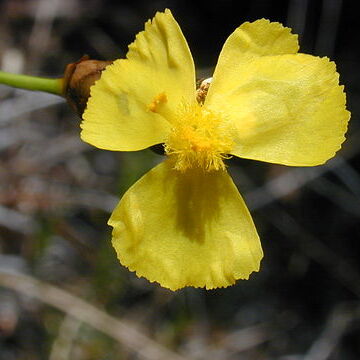Perennial or sometimes annual, tufted ‘grass-like’ herbs, usually of marshy areas. Leaves mostly or all basal, alternate, distichous or spirally arranged, basally with an open sheath, sometimes ligulate (not in Australia); lamina narrow, flat to cylindric or filiform, sometimes compressed (not in Australia). Inflorescence a terminal or lateral, globose or cylindrical spike, usually scapose; scapes usually many, usually as long as the leaves. Flowers bisexual, actinomorphic to zygomorphic, sessile (in Australia), subtended by a bract. Sepals (2) 3, subequal, 1 sometimes reduced to a scale or membranous, wrapped around the corolla and falling as the flower opens. Petals 3, usually yellow, equal or subequal, clawed or sometimes basally united with spreading lobes. Stamens 3 (–6), opposite and usually united to petals; anthers 2-locular, dehiscing via longitudinal slits; staminodes sometimes present, 3, filaments sometimes fringed. Gynoecium of 3 fused carpels. Ovary superior, 1-or 3-locular, sometimes incompletely so; ovules many per locule; style simple or 3-branched. Fruit a capsule, opening loculicidally or irregularly dehiscent, sometimes enclosed by persistent corolla tube. Seeds small, usually numerous, longitudinally ribbed, endosperm present.
Herbs perennial or rarely annual. Roots fibrous. Leaves mostly basal, distichous or sometimes polystichous, sheathing; leaf blade ensiform, linear, or filiform. Scapes or peduncles usually numerous. Inflorescence terminal, a globose to cylindric head or dense spike; bracts conspicuous, spirally imbricate or decussate, persistent or sometimes caducous in fruit. Flowers bisexual, 3-merous. Sepals 3, sometimes median sepal reduced or absent, lateral sepals 2, chaffy-scarious, keeled. Corolla actinomorphic or rarely zygomorphic, usually ephemeral; petals 3, yellow, less often white or blue, free, base clawed or sometimes connate, or forming a long tube. Stamens usually 3, inserted opposite petals; filaments short, adnate to petals, rarely free; anthers 2-loculed, dehiscing longitudinally. Staminodes present or absent. Ovary superior. Style filiform, apex 3-branched or simple. Capsule oblong, 3-valved, loculicidal. Seeds with copious and ± mealy endosperm; embryo small.
Annual or perennial herbs, often in seasonally or permanently wet sites; stems upright, base sometimes swollen in perennial species. Leaves alternate, simple, linear, distichous, few to numerous, basal sheath open, blade flattened to terete. Inflorescence a condensed pedunculate spike; flowers in the axils of densely crowded often coriaceous bracts, forming a spherical, ovoid or elongate head (the spike). Flowers 3-merous, bisexual; calyx-lobes 3, the adaxial at first forming a hood-like structure over the bud, the laterals smaller; corolla tubular, divided above into 3 broad spreading usually yellow but sometimes white, blue or orange petals. Stamens 3, opposite the petals, often with 3 staminodes alternating with them. Ovary (1–)3-locular, with numerous ovules and axile or parietal placentation; style 1, sometimes divided into 3 at the apex. Fruit a loculicidal or irregularly dehiscent capsule. Seeds numerous, small, with endosperm
Flowers hermaphrodite, slightly zygomorphic, arranged in pedunculate terminal globose or cylindrical heads; bracts imbricate, leathery or rigid, the lower sometimes forming an involucre
Sepals 3 or rarely 2, the lateral 2 exterior, boat-shaped, keeled, glumaceous, the third interior, membranous, forming a hood over the corolla and pushed aside as the latter develops
Stamens 3, opposite the corolla-lobes, and 3 alternate staminodes or the latter absent; anthers 2-locular, opening by slits
Ovary superior, 1-locular, with 3 parietal placentas or imperfectly 3-locular at the base; style simple or 3-lobed
Leaves mostly radical, tufted, linear, terete or filiform, sheathing at the base
Corolla with a short or long tube and 3 equal spreading lobes
Fruit a capsule enclosed in the persistent, corolla-tube
Seeds numerous, with copious endosperm and small embryo
Perennial or annual herbs
Ovules numerous to few

